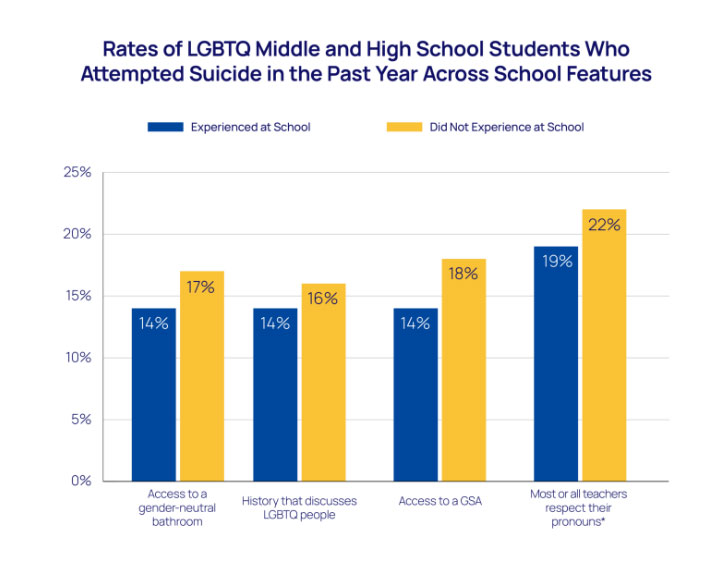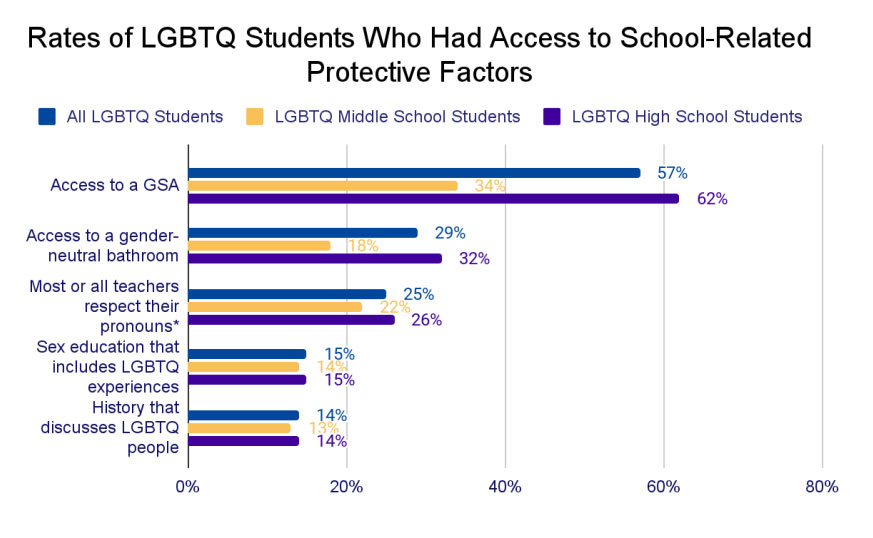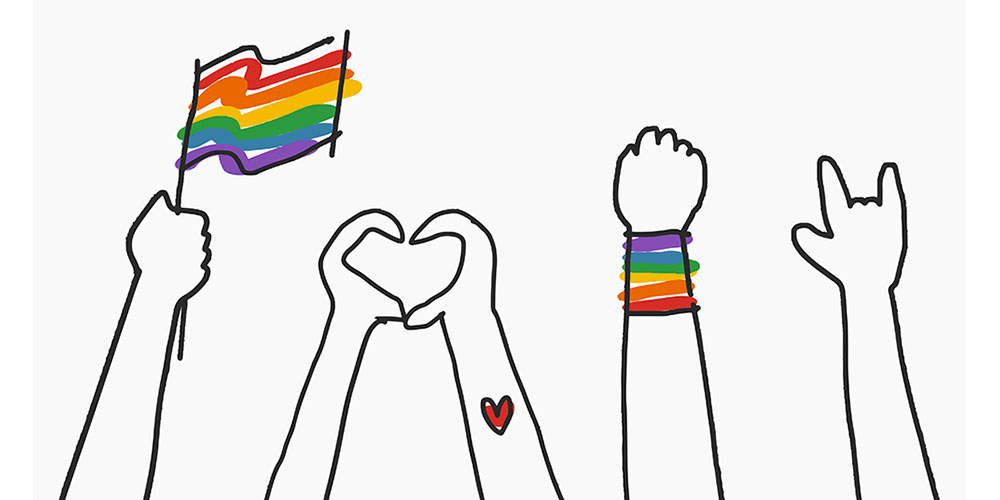Suicide is the second-leading cause of death among people ages 15-24. According to the National Alliance on Mental Illness, nearly 20% of high school students report having serious thoughts about suicide, and 9% have attempted suicide. The numbers are even more concerning among lesbian, gay, bisexual, transgender, and queer (LGBTQ) youth.
The Trevor Project’s 2023 U.S. National Survey on the Mental Health of LGBTQ Young People found that 46% of LGBTQ teens, ages 13-17, and 34% of LGBTQ adults, ages 18-24, considered suicide in the past year. The study also found that 14% of LGBTQ youth actually attempted suicide in the past year, including nearly one in five transgender and nonbinary people.
The same study, which surveyed more than 28,000 LGBTQ people ages 13-24, shows there are proven ways schools can reduce LGBTQ student suicide risk. LGBTQ middle and high school students with access to at least one of the following school-related protective factors had 26% lower odds of attempting suicide in the past year:
- Access to a gender-neutral bathroom
- Teachers who respect students’ pronouns
- History classes that discuss LGBTQ people
- Sex education that includes LGBTQ experiences
- Access to a Gay-Straight Alliance (GSA)
The graphic below breaks down the rates of LGBTQ middle and high school students who attempted suicide in the past year in comparison to whether or not they had access to a school-related protective factor. (Note: Learning about LGBTQ experiences in sex education was not associated with significantly different rates of suicide attempts in the past year, but it was associated with lower rates of considering suicide in the past year.)

Source: The Trevor Project
The study also determined 70% of middle and high school LGBTQ students had access to at least one school-related protective factor. Overall, 35% of LGBTQ students had access to only one of these protective factors, 36% had access to at least two, 14% had access to at least three, 4% had access to at least four, and only 1% had access to all five.
Here it is broken down by most common school-protective factor to least:
- 57% attended a school with a GSA or similar club in the most recent school year
- 29% had access to a gender-neutral bathroom
- 25% said most or all teachers respected their pronouns
- 15% were taught sex education that included discussions about LGBTQ people and experiences
- 14% were taught history that included LGBTQ stories and people
The below graphic from the study breaks down access by middle school and high school.

Source: The Trevor Project
The 2023 survey also breaks down some of its findings by various categories, including age, sexual orientation, gender identity, race/ethnicity, and region. Additionally, it provides statistics on anxiety and depression, access to gender-affirming medical care, anti-LGBTQ victimization, and more.
Some additional significant findings from the survey include:
- Transgender and nonbinary young people who reported that all of the people they live with respect their pronouns reported lower rates of attempting suicide
- Fewer than 40% of LGBTQ young people found their home to be LGBTQ-confirming
- 55% reported their school was LGBTQ-affirming
- Students who had at least one school-related protective factor had three times higher odds of reporting their school as LGBTQ-affirming
- Roughly half of transgender and nonbinary young people found their school to be gender-affirming, and those who did reported lower rates of attempting suicide
- A majority of LGBTQ young people reported being verbally harassed at school because people thought they were LGBTQ
Legislation, Lack of Mental Health Professionals Impacting LGBTQ Youth Mental Health
While the study shows school-protective factors make a difference, the Trevor Project warns many recently passed state laws may prevent some schools from implementing them. As of June 2023, over 100 curriculum censorship state-level active bills have been proposed. The study found nearly two in three LGBTQ youth said hearing about potential state or local laws banning people from discussing LGBTQ people at school made their mental health a lot worse, and nearly one in three said their mental health was poor most of the time or always due to anti-LGBTQ policies and legislation.
“These bills are in direct contradiction to these findings and other scholarship (Russel et al, 2018.; Hatzenbuehler 2011), which have documented the relationships between the affirmation of LGBTQ identities in schools and better mental health among LGBTQ students,” says the nonprofit. “Parents/caregivers, teachers, school staff, and other stakeholders should advocate on behalf of LGBTQ young people to ensure they are just as comfortable, safe, and affirmed as their cisgender and straight peers at school.”
Barriers to mental health support are also exacerbating the issue. Approximately 81% of LGBTQ young people said they wanted access to mental health care, but a whopping 56% of those who wanted mental health care in the past year were not able to get it. This comes as no surprise since the current national average ratio of school counselors to students is 444:1. The American School Counselor Association (ASCA) recommends at least one counselor for every 250 students. Only two states met that criteria as of Dec. 2022: Vermont (186:1) and New Hampshire (208:1).
There is also a significant shortage of school psychologists. According to the National Association of School Psychologists (NASP), the recommended ratio is one school psychologist for every 500 students. Data from NASP shows that as of Jan. 10, 2023, the national average is one psychologist to every 1,127 students — over 100% more than the recommended ratio.
How Can Schools and Individuals Support LGBTQ Students?
LGBTQ young people who took the Trevor Project survey reported that the following LGBTQ topics would be helpful for the people in their lives to know more about:
- Support/acceptance (82%)
- Gender identity (78%)
- Sexual orientations (77%)
- Pronouns (74%)
- Creating safe spaces (68%)
- The gender binary (67%)
- Microaggressions (58%)
- Racism (52%)
- Intersectionality (45%)
The Trevor Project encourages schools to implement the Model School District Policy on Suicide Prevention, which the group developed in collaboration with the American Foundation for Suicide Prevention (AFSP), the American School Counselor Association (ASCA), and the National Association of School Psychologists (NASP). Its website also offers several resources for adults working with or living with LGBTQ youth, including the Guide to Being an Ally to Transgender and Nonbinary Youth, How to Support Bisexual Youth, and Preventing Suicide.
The nonprofit’s TrevorSpace social media platform, which is monitored 24/7, also connects young people with supportive peers and affirming counselors when they are in crisis.







